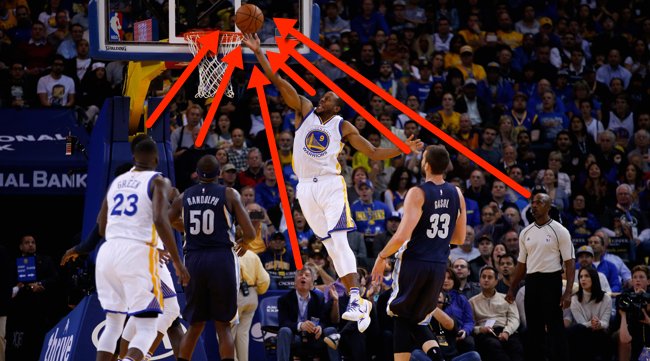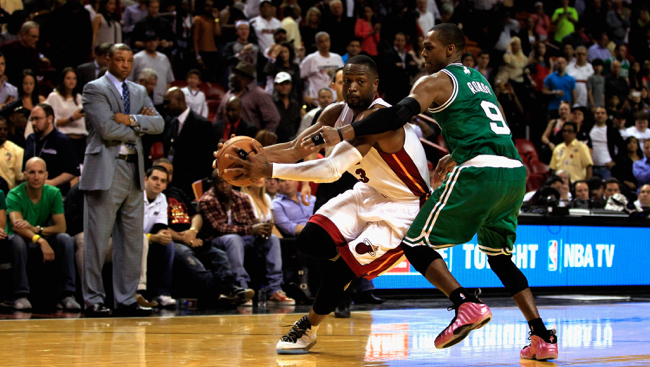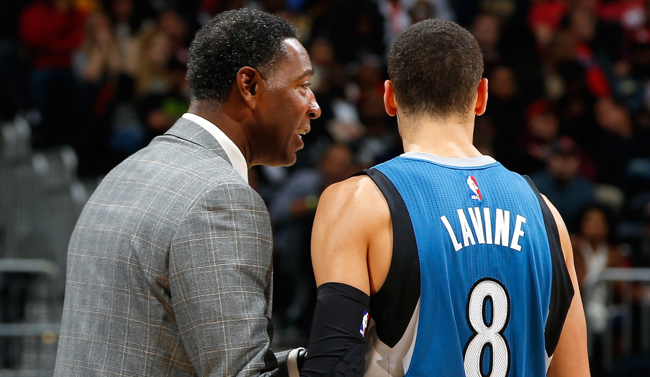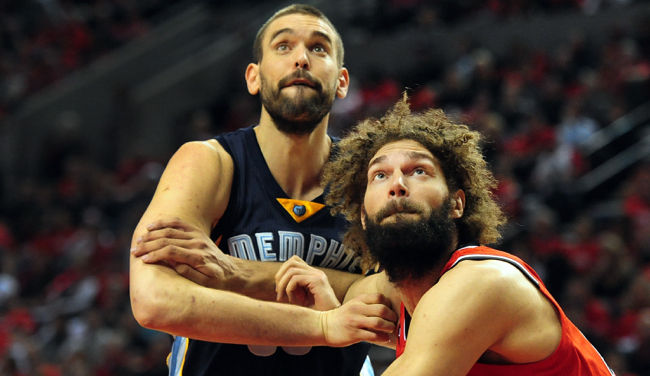
The eye is trained to follow the ball when watching sports. In basketball, so much is going on away from the ball, most writers and analysts have to go back and watch film to catch the various off-ball movements that make up the majority of a basketball game. DIME scribes aren’t the usual basketball fans, though, and a lot of them watch away from the ball in real time. Here’s who they’re looking at, and why.
Jack Winter
I pay extra attention to all non-shooters who do a lion’s share of playmaking. Rajon Rondo, Ricky Rubio, Michael Carter-Williams, and Elfrid Payton come to mind first as point guards, but guys like Dwyane Wade also fit that mold.

Are they spacing the floor to the arc on the weak side or standing a few steps inside it? Do they take advantage of defenders overloading the strong side with well-timed cuts that produce points? Do they take advantage of the defender going under in ball-screen action by confidently shooting jumpers?
Those are some of the questions that decide whether or not the glaring flaw of shooting can be somewhat mitigated. And in the modern NBA, answering them positively matters more than ever. There’s only so much space on the floor, and playing a small that doesn’t capably stretch it naturally limits the ceiling of a team’s offense. But players who present that problem can still lessen it with canny, active, and decisive movements; overall, that’s what I’m looking for more than anything else while watching them operate without the ball.
Jordan White
There are two types of players I tend to watch off-ball: the elite, and young players — particularly rookies or sophomores.

Kyle Korver and J.J. Redick are delightful to watch off the ball. They curl and dash and twist and turn all over the court, using any and every screen they get to find just a hair of an opening. The offense knows what’s coming, especially with Korver, and it’s so interesting to see those players beat the defense regardless – a case of an individual’s best versus a team’s best effort.
As for the younger players, the two I’ve grown to watch the most are Zach LaVine and Aaron Gordon, for different reasons. Gordon has all of the tools to be the next coming of Shawn Marion – lofty praise, to be sure, but Gordon is capable of reaching those heights. He’s an exceptional athlete, has an inherent and growing understanding of using screens, and doesn’t need the ball to be dangerous. If anything, he might be more dangerous without it. Watching him grow into this role in real-time is a treat.
When it comes to LaVine, I watch him because I still don’t know what his role will be in the NBA. Is he a one? Is he a two? Is he a combo? He’s an NBA player, that much is true, but beyond that, it’s mostly question marks. If the two is his destiny, he needs to become better at playing without the ball. So far, the results have been a mixed bag. He’ll show flashes of great awareness, making a timely cut to the basket or to the three point line for an open shot. On other occasions, though, he seems generally lost, struggling to navigate screens and move with purpose.
Jamie Cooper
I’m going with an embarrassingly obvious and un-creative answer here, mostly because I honestly don’t spend a lot of time watching players play off the ball. But I love watching Steph Curry curl around three or four consecutive screens every other play to get a good look at a three (not that he even needs a good look anymore), and I particularly enjoyed when the Warriors started running those super cool elevator screens a couple of seasons ago.
Historically, it’s been other shooters like Reggie Miller and Rip Hamilton, and probably Ray Allen as well — later in his career — who were so deadly in those catch-and-shoot situations running around the same barrage of screens Curry does today. But one player in particular who used to make my head spin was Tony Parker. He never stopped moving without the ball, especially when he was a bit younger and had an endless supply of energy and was just so quick and crafty and relentless that if you lost sight of him for even a split second he would absolutely make you pay.
Matt Rothstein
When I watch players off the ball, it tends to be big men. The battle down low for post position is tougher and more complicated than it’s ever been, and overcommitting to posting up can be detrimental to NBA offenses that often work with constant screening. Big men have to choose how to affect the offense, and balance that with getting offensive rebounding position.

The big men I enjoy watching off the ball most are the ones with the most responsibilities — DeMarcus Cousins and Marc Gasol come to mind first, especially as Boogie’s extended his range. They’re viable threats with or without the ball all over the floor, and they’re also focal points of the offense, so to watch them pick and fight for their spots is a great game-within-the-game.
Spencer
I don’t really watch specific players off the ball, but specific components of a play, especially if it’s one I’ve seen before — and almost all of them are just riffs on the same thing. I’ll use a standard high screen as an example because they’re so ubiquitous in today’s game. For the most part, I’ll watch the backline defender as the offensive player turns the corner and pauses before making his move. I’ll watch the spacing of the other offensive players and who scares opposing defenses enough that their man stays at home, even as the offensive player cruises by — unmolested — for a high-percentage shot at the iron. I’ll even watch the movements on the other side of the court. Are players at a standstill, or are they drifting towards better passing angles along the arc?
Here’s a random pick-and-roll play I selected from Wednesday night’s Wizards-Spurs game. David West sets a high screen for Tony Parker, who uses the screen to go all the way to the baseline where he misses a heavily contested jumper. It’s a play that doesn’t inspire much from a fan, but I might watch any number of players scattered across the court and draw inferences from what they’re doing, or even not doing.
https://media.giphy.com/media/26tPdCQltQeYIkgQ8/giphy.gif
First, I was wondering about David West and TP. They haven’t played together enough to develop the subconscious rapport Parker has with Duncan, and while this is certainly on the ball, I did notice that Parker went a little early, and West wasn’t in the best position to pick off his defender, Wall.
And holy hell, it’s a special player who can squeeze over the screen like John Wall does here. He also trails the play the way he should, though a stickler would want him hugging TP’s hip a little closer. Again, not necessarily off the ball, but this is just one of a multiple ways I might watch the play. Now for the off-the-ball inferences.
Another player who might draw my eyes while watching the play is Otto Porter. Kawhi Leonard is now leading the league in three-point percentage and Porter is sticking pretty close to him despite his presence on the weak side of the floor. This mastery of half-court spacing is actually a mastery, as you’ll see.
Then there’s Ramon Sessions, who is guarding Danny Green.
Sessions is on the strong-side, and most defenders in that position would pinch a little closer to the lane, and take a real swipe at Parker’s dribble as he turns south towards the cup. But the presence of Danny Green in that near corner is enough of a threat to keep him at home and provides Parker a nice lane to the iron. Except, Green — a career 41 percent shooter from deep and the NBA record holder for triples in a Finals series — is shooting 29.3 percent from downtown this year. With the addition of Aldridge and West, he’s getting his looks at different spots on the floor, and that takes some adjustment. Nevertheless, Sessions stays home and Parker gets a lane to the rim.
If I’m being honest at this point, this last snapshot is what I was looking at the first time I watched.
Acculturating LaMarcus Aldridge into the Spurs’ motion offense is the biggest question mark in their quest to upset the Warriors, so my eyes naturally draw to the former Blazer big man when the Spurs are on offense. I watch so much of the Spurs, I usually know where everyone else is going to be, or what role they’ll play in a half-court set — especially with Parker out there. Not so with Aldridge.
On this play, he gets stuck under the basket and doesn’t slide to the opposite side, allowing his defender — Kris Humphries — to seal off any possible scoop shot by Parker past Marcin Gortat.
Instead, Parker is forced into an awkward pull-up that misses because of the presence of Gortat.
***
So much happens away from the basketball on the hundred or so possessions each team gets in an average NBA game. Who do you watch off the ball? Or perhaps the more astute question would be: What do you watch off the ball?






